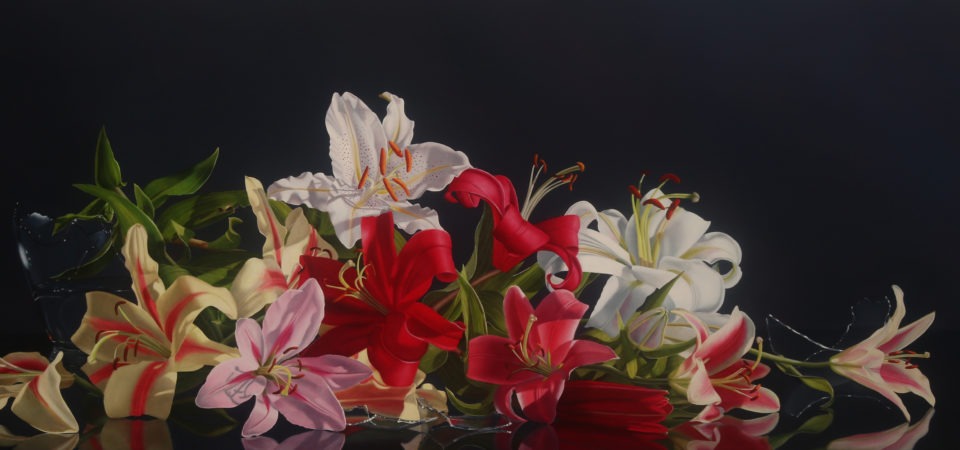My love and reverence for Nature have always guided the imagery in my paintings.
As a young person, I traveled all over Colorado with my grandparents, camping and learning to appreciate the beauty that was all around me. As we hiked, fished, and enjoyed “scenic overlooks”, I experienced beauty, grandeur, and endless landscape views that filled my young soul, and while camping and fishing, I experienced the tastes and smells, and delicate details that nature had to offer.
Two very important things were happening; I was experiencing nature with all of my senses thus imprinting lifelong memories, and I was being taught how to categorize those experiences as beautiful and wonderful and to place great value on all of them. It was only later that I would learn that the experiences were extraordinary, powerful, and guides for my aesthetics and principles as I journeyed through my life.
It highlights for me the importance of “teaching” people, young people especially, to understand and value nature as the source of physical life, as well as a potential source for creativity, spirituality, emotional balance, and beauty.
My path to and through life as an artist took me through Bachelor’s Degree in Science, focused on biology, which taught me the elegance and balance of living systems from single cells to ecosystems. The next educational journey was through art school, learning how to think about art and art-making, and art history, where I found stories so interesting and profound that the next educational journey would be a Master’s Degree in those stories. And my education continued during a lengthy college teaching career that enriched my life as an artist immeasurably.
Through many years of these journeys, I have also been gardening, an activity that feeds my curiosity about living systems, and my creativity as an artist. In the many years that I have gardened at the base of the eastern side of the Rocky Mountains, I have seen changes in climate that should have taken far longer to happen. It has been extremely alarming to see the fruition of the potential changes that we considered in my college years 50 years ago. I love, admire, and respect the strong and exquisite balances in living systems, and have been horrified to watch that strength turned to fragility, as the balances become untenable. Nature, as I have known and loved it, is being systematically destroyed, in an incomprehensibly short amount of time, for the ugliest characteristic that humans possess: greed.
While in art school a very wise teacher told me, ”Paint that which you feel most passionate about.” It was advice that has carried me through my over 30-year art career and kept me going when I wanted to quit. And so, I have always painted nature, and my choice of what part of nature to paint is flowers. Georgia O’Keeffe said, “Nobody sees a flower really; it is so small. We haven’t time, and to see takes time – like to have a friend takes time.” In my paintings, I want to give people the time to really see flowers and appreciate them, and value them, and by extension, value nature.
Visually flowers are fascinating, and in the right light, they look like pieces of stained glass – glorious and luminous. In the history of Christian architecture stained or colored glass or stone (alabaster) has been used to color the light inside churches, making them other-worldly and special. The way that the colors of flowers interact with light makes them extraordinary. In my paintings, they are emissaries and symbols of nature.
In my paintings, I have placed flowers on altar-like tabletops, on marble and other stones that come from Earth, with draperies that move like air, and occasionally on construction materials, which are always symbols. As a painter of trompe l’oeil and photorealistic flowers, I have also had a love affair with the 17th Century Dutch floral painting, much of which uses symbols to convey the artist’s intentions and meaning. While they used a symbolic language that was known by most at the time, we live in a time where the symbolic language is mostly limited to emojis and advertising. So, I have made up my own.
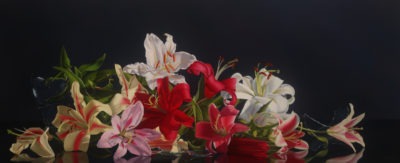
My intention is to create meaning and communication in my paintings, but also to add beauty from the natural world to people’s lives. That means that my symbolism is limited to things that are life-affirming to live with, rather than an ugly statement. People respond to beauty in positive ways and will spend much more time with something positive than a thing that pushes them away. Even though I sometimes use imagery that is uncomfortable, I portray it as beautifully as I can. This way, by the time the viewer realizes there is something amiss, they are already engaged with the communication. In both “Closing In” and “Broken” the ugliness is cloaked in beauty.
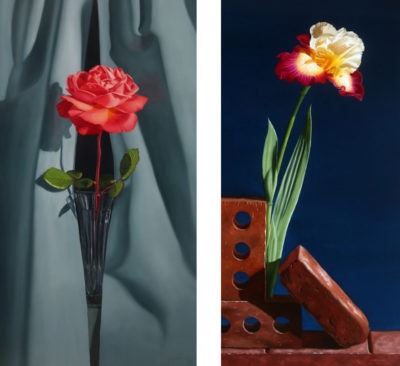
Other symbols that I use are rocks as representatives of the earth and the life that it supports: glass as a symbol of the fragility of life, construction materials as symbols of man-made destruction, tissue paper, and glass cloches as symbols of protection, broken glass as a symbol of the brokenness of nature, smoked glass as a reference to the endless fires around the planet, and dice as symbols of luck and chance in the success of growing plants. Each of these symbols is intended to be a subtle reminder to the viewer. Like most artists, my communication is only complete when it reaches another person. Before it can do that though, it has to feed my desire to communicate a message that is important enough to me to spend my life on it.
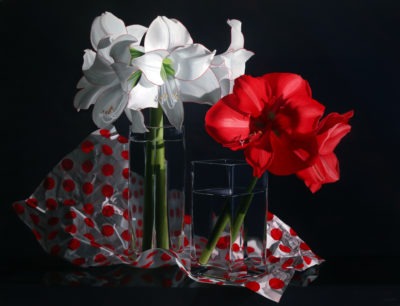
I have grown and painted flowers for many years and with this exhibition, I am challenging myself to use my floral imagery to express my distress and anguish about how climate change is threatening the survival of life and nature as we know it on this planet.
My hope is that as people spend time with the beauty of nature in my paintings, they will learn to value it and emotionally engage enough to consider their own relationship with the planet.
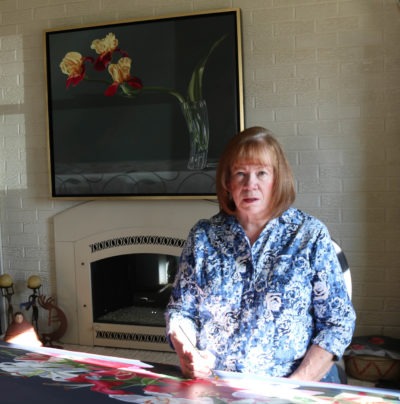 Jane Jones is a Denver native and continues to live near there at the foot of the Rocky Mountains, where the light that she loves is bright and clear, and the seasons, which influence her work, are definite in their character and moods.
Jane Jones is a Denver native and continues to live near there at the foot of the Rocky Mountains, where the light that she loves is bright and clear, and the seasons, which influence her work, are definite in their character and moods.
Earning a Bachelor of Science degree in Biology in 1976, Jones chose not to work in that field. She says of the education that “Looking into the lives of cells, plants, animals, and ecosystems gave me a glimpse into the awesome power of living things and an incredible respect for them”, which informs her work today.
Her still-life paintings combine historical roots in 17th-century Dutch painting, with a contemporary hyper-realistic style. She uses multiples layers of underpainting and glazing to bring her subjects to life. Symbols are used to communicate her love of nature and the threats that nature faces while presenting the beauty, power, and fragility that need to be protected and nurtured.
Jones’ work is exhibited nationally in museums and galleries. Her paintings have won numerous national awards including the Award of Excellence in Blossoms II: Art of Flowers at the Naples Museum of Art in 2011, the Floral Award in the Annual Exhibition of the International Guild of Realism in 2013 and 2018, and she is the author of Classic Still Life Painting, published by Random House.
Artworks pictured in this post will be featured in the traveling museum exhibition, CULTIVATING THE DUTCH TRADITION IN THE 21st CENTURY – Jane Jones’ Hyperrealist Floral Paintings.
Produced by David J. Wagner, L.L.C.
Information about the exhibition is available at:
https://www.davidjwagnerllc.com/Dutch_Tradition_Floral_Paintings.html
Jane Jones’ other work can be seen at janejonesartist.com
The MAHB Blog is a venture of the Millennium Alliance for Humanity and the Biosphere. Questions should be directed to joan@mahbonline.org
The views and opinions expressed through the MAHB Website are those of the contributing authors and do not necessarily reflect an official position of the MAHB. The MAHB aims to share a range of perspectives and welcomes the discussions that they prompt.

